|
|
|
Sort Order |
|
|
|
Items / Page
|
|
|
|
|
|
|
| Srl | Item |
| 1 |
ID:
190026
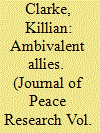

|
|
|
|
|
| Summary/Abstract |
Since the Cold War ended, foreign support has been identified as an important factor in facilitating democratization. However, in certain parts of the world Western enthusiasm for democratization has been highly uneven, particularly when regime change has been achieved through nonviolent revolutionary mobilization. This article introduces the concept of ‘ambivalent allies’ and argues that ambivalence may be highly detrimental to new democracies emerging from nonviolent resistance. Ambivalent allies signal public support for a democratic transition while remaining quietly skeptical about the desirability or viability of the new regime. These misleading signals cause democratic leaders to deprioritize the maintenance of their diverse coalitions, choosing instead an exclusivist approach that alienates their domestic partners. They therefore end up doubly exposed to counterrevolutionary threats, lacking both a broad domestic support base and strong foreign backers. The article illustrates this argument through an examination of Egypt’s 2011 revolution and 2013 coup, drawing on approximately 100 interviews with Egyptian political leaders and foreign diplomats. It shows that the USA’s ambivalence toward the transition contributed to the coup by giving the elected government headed by Mohamed Morsi a false impression that it had strong foreign backing, and that it could afford to marginalize the secularist wing of the original revolutionary coalition. Egypt’s experience is then compared to two cases in which new governments survived counterrevolutionary threats: Burkina Faso in 2014 and Madagascar in 2009. The study contributes to our understanding of how international support may facilitate or undermine democratic consolidation following nonviolent revolutions.
|
|
|
|
|
|
|
|
|
|
|
|
|
|
|
|
| 2 |
ID:
090861


|
|
|
|
|
| Publication |
2009.
|
| Summary/Abstract |
This article investigates the limitations of peace theory in comparing and contrasting strategies adopted by activist groups working to resolve conflicts of varying types in varying contexts. Using the case of seven Israeli and Palestinian peace and justice groups that remained active after the collapse of the Camp David negotiations and the outbreak of the Second Intifada, the article illustrates the benefits of a process-based approach to peacebuilding for examining how, why, and to what extent approaches used by these groups changed between 2004-05 and 2008. The findings highlight how domestic, regional, and international changes have affected the operation of peace and justice activists, and suggest that those interested in progress towards a negotiated peace agreement should not assume that past policy instruments will work in the current environment.
|
|
|
|
|
|
|
|
|
|
|
|
|
|
|
|
| 3 |
ID:
133474
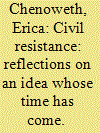

|
|
|
|
|
| Publication |
2014.
|
| Summary/Abstract |
IT HAS BEEN THREE YEARS SINCE WHY CIVIL RESISTANCE WORKS HIT THE shelves.1 When Maria J. Stephan and I sent the final galleys into the publisher, we had no idea that the Arab Spring was about to grip the world; that the Occupy movement would reenergize the protest sector in advanced
democracies; or that countries as diverse as Turkey, Venezuela, Ukraine, Thailand, and India would be rocked by nonviolent resistance against entrenched authority, lack of economic opportunity, and corruption. While many people have cataloged the global decline in armed conflict, few have noticed that, in the meantime, the use of civil resistance has been on the rise.
|
|
|
|
|
|
|
|
|
|
|
|
|
|
|
|
| 4 |
ID:
112172
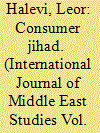

|
|
|
|
|
| Publication |
2012.
|
| Summary/Abstract |
This article deals with the origins, development, and popularity of boycott fatwas. Born of the marriage of Islamic politics and Islamic economics in an age of digital communications, these fatwas targeted American, Israeli, and Danish commodities between 2000 and 2006. Muftis representing both mainstream and, surprisingly, radical tendencies argued that jihad can be accomplished through nonviolent consumer boycotts. Their argument marks a significant development in the history of jihad doctrine because boycotts, construed as jihadi acts, do not belong to the commonplace categories of jihad as a "military" or a "spiritual" struggle. The article also demonstrates that boycott fatwas emerged, to a large degree, from below. New media, in particular interconnected computer networks, made it easier for laypersons to drive the juridical discourse. They did so before September 11 as well as, more insistently, afterward. Their consumer jihad had some economic impact on targeted multinationals, and it provoked corporate reactions.
|
|
|
|
|
|
|
|
|
|
|
|
|
|
|
|
| 5 |
ID:
126940
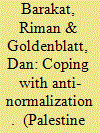

|
|
|
|
|
| Publication |
2012.
|
| Summary/Abstract |
The issue of anti-normalization has been attracting the attention of a growing number of Palestine activists. In recent months, several joint Israeli and Palestine activities have been targeted and disrupted by “anti-normalization” protesters. The issue has provoked concern among Israeli NGOs and international donors alike- the former being involved in a range of joint Israel-Palestine activities, and the latter funding those activities. The positions of Palestine NGOs are mixed. While some groups engage with Israelis in a tacit and low-profile manner, others have ended their involvement in joint activities altogether, regardless of the nature and purpose of the joint effort. Other Palestinian activists welcome joint nonviolent resistance to the occupation as in the cases of the solidarity campaigns in Sheikh Jarrah, Budrus, Ni'Lin, Bil'in, Nabi Saleh, Kufer Qadem and more. It should be also noted that there is a general exhaustion on the Palestine side, which has nothing to do with attitudes toward Israeli-Palestine dialogue and joint activity. The general sentiment among Palestine is that they should direct their energy toward developing Palestine institution and society and achieve a certain level of equality on all level before engaging with Israelis.
|
|
|
|
|
|
|
|
|
|
|
|
|
|
|
|
| 6 |
ID:
148477
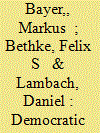

|
|
|
|
|
| Summary/Abstract |
Research suggests that nonviolent resistance (NVR) campaigns are more successful in deposing dictators than armed rebellions. However, ousting dictators is only the first step in the process of democratization. After deposing an autocratic regime, societies enter a transition phase where they must learn to consolidate the gains of democracy and bargain about the new rules of the democratic regime. But even if free, fair, and competitive elections are held, indicating a successful transition to democratic rule, uncertainty about its stability remains salient. In the period that follows, either democracy survives and proves to be resilient, or an autocratic backslide occurs. In this article, we analyze the effect of NVR campaigns on the survival of democratic regimes. Building on the literature on modes of transitions and nonviolent resistance, we argue that those democratic regimes that come into being as a result of a NVR campaign are less prone to democratic breakdown. The main mechanism which produces this effect is that the organizational culture of NVR campaigns spills over to the subsequent democratic regime fostering conditions favorable for democratic survival. We test the effect of NVR campaigns on democratic regime survival using survival analysis and propensity score matching. The results show that democratic regimes that experience NVR during the transition phase survive substantially longer than regimes without NVR.
|
|
|
|
|
|
|
|
|
|
|
|
|
|
|
|
| 7 |
ID:
132148
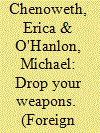

|
|
|
|
|
| Publication |
2014.
|
| Summary/Abstract |
Over the past three years, the world has witnessed a surge of nonviolent resistance movements. Pictures of huge demonstrations in public squares have become a staple of international news broadcasts, and Time named "the protester" as its Person of the Year for 2011. These days, it seems that at any given moment, thousands of people are mobilizing for change somewhere in the world.
|
|
|
|
|
|
|
|
|
|
|
|
|
|
|
|
| 8 |
ID:
120774
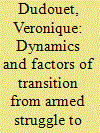

|
|
|
|
|
| Publication |
2013.
|
| Summary/Abstract |
The dynamics of conflict (de)escalation by social movements or political opposition groups have attracted cross-disciplinary interest among social scientists, but there remain several knowledge gaps to be filled. On the one hand, there is already extensive research on the shifts from unarmed expressions of collective grievances to the adoption of violent strategies by oppressed constituencies or 'minorities at risk', as well as on the transition from armed insurgency to negotiations, demobilization, reintegration and conventional politics. However, there is scarce scholarship on the phenomenon of armed groups shifting their conflict-waging strategies from violent to nonviolent means, especially in contexts which cannot be resolved by force but are also 'unripe' for conventional de-escalation methods through negotiation and political integration. This article offers a first attempt to fill this conceptual and empirical gap, by investigating the nature and the drivers of transitions from armed strategies to nonviolent methods of contentious collective action on the part of non-state conflict actors. It focuses in particular on the internal and relational/environmental factors which underpin their decisionmaking process, from a change of leadership and a pragmatic re-evaluation of the goals and means of insurgency, to the search for new local or international allies and the cross-border emulation or diffusion of new repertoires of action. This multilevel analysis draws from past research on various self-determination or revolutionary movements which fit the scope of analysis (i.e. Nepal, Egypt, Palestine, West Papua, East Timor, Mexico and Western Sahara). The article also points to the need for more systematic enquiry on these cases through in-depth comparative empirical analysis.
|
|
|
|
|
|
|
|
|
|
|
|
|
|
|
|
| 9 |
ID:
171988
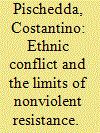

|
|
|
|
|
| Summary/Abstract |
Recent research shows that campaigns of nonviolent resistance are much more successful in producing radical political change than armed rebellion. I argue that the study of nonviolent resistance has paid insufficient attention to a key condition for success—a shared ethnic identity between challengers and government. When challengers and incumbent belong to different ethnic groups, the prospects of campaign success are drastically curtailed, as this situation of “ethnic conflict” inhibits the mechanisms through which nonviolent resistance enables success: emergence of a critical mass of challengers, defection of segments of the security apparatus and the regime inner circle, and development of feelings of sympathy for the opposition cause among key government decision makers. Statistical analysis of all nonviolent campaigns from 1945 to 2006 supports my argument. Nonviolent ethnic campaigns are significantly and substantially less likely to succeed and draw both fewer participants and government defectors than their nonethnic counterparts.
|
|
|
|
|
|
|
|
|
|
|
|
|
|
|
|
| 10 |
ID:
186781
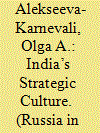

|
|
|
|
|
| Summary/Abstract |
India is emerging as a global power, but its strategic culture remains
largely understudied. Expert literature calls into question the very
existence of India’s own “systemic” strategic thinking. The article probes
into the validity of this viewpoint, postulates that India has its own
strategic culture, and highlights its key elements.
With the help of Michel Foucault’s genealogical method, the genealogy
of the concepts of ‘war’ and ‘power’ in Indian political philosophy is
examined and, on this basis, the central conceptual elements of India’s
military-political system are determined.
This approach shows that India’s strategic culture is distinguished not only
by its own systemic strategic thinking, but also by an original (different
from the Western one) way of structuring and coding the conceptual space
of ‘society,’ ‘politics,’ and ‘statehood.’ This gives an idea of how war and
strategy were understood in Indian culture in the past and how they are
seen today.
|
|
|
|
|
|
|
|
|
|
|
|
|
|
|
|
| 11 |
ID:
160472
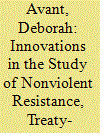

|
|
|
|
|
| Summary/Abstract |
The third issue of JoGSS’ third volume opens with a special, guest-edited section introducing new ways to explore nonviolent resistance—a form of conflict in which unarmed persons use a wide variety of coordinated tactics to push for change without harming others. As Braithwaite and Braithwaite note in their introduction to the special section, the quantitative study of nonviolent resistance has recently become much more prominent in the field. They curated for this issue a series of new studies that disaggregate actors and tactics to uncover new insights regarding the role of ethnic power relations on the participant bases of nonviolent and violent resistance campaigns, the role of fear of victimization in patterns of mobilization, the effects of state response in protest dynamics, the role of national trade unions in the duration and outcomes of nonviolent campaigns, and the role of the United Nations in the diffusion of norms of nonviolence across secessionist movements.
|
|
|
|
|
|
|
|
|
|
|
|
|
|
|
|
| 12 |
ID:
190022
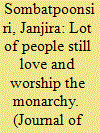

|
|
|
|
|
| Summary/Abstract |
This article examines the interplay between nonviolent movements’ use of polarizing issues for mobilization and pro-regime countermobilization. Thailand has been chosen as an explanatory case study because it has a history of political polarization and pro-regime mass mobilization. I focus on polarizing frames that were incorporated into the 2020 nonviolent resistance campaigns, which addressed a taboo subject in the country: the monarchy. In response, the regime applied various forms of repression, including the mobilization of royalists. But the assumption that the regime single-handedly mobilized countermovements is only half of the story. Autonomous elements within countermovements also joined forces when there were sufficient social conditions. By juxtaposing protest event data with an analysis of mobilizing frames (through movements’ Twitter hashtags), I shed light on a two-pronged process that underpins the nexus between framing choice and countermobilization: (a) how a movement’s choice for polarizing frames sustains existing ideological and identity-based cleavages, antagonizing segments of society that perceive their collective identity to be under siege and; (b) how these ideological and identity-based cleavages also provide social sources for countermobilization. I conclude by addressing some implications of this framing choice–countermobilization nexus on repression dynamics and suggest how we can rethink the relationship between strategic framing and nonviolent resistance campaigns in divided societies.
|
|
|
|
|
|
|
|
|
|
|
|
|
|
|
|
| 13 |
ID:
155781
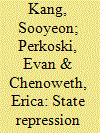

|
|
|
|
|
| Summary/Abstract |
In this article, we review decades of research on state repression and nonviolent resistance. We argue that these two research programs have converged around six consensus findings. We also highlight several areas of divergence, where greater synthesis between the research on state repression and nonviolent resistance might prove useful. We draw attention to remaining controversies surrounding the association between state repression and nonviolent resistance—particularly regarding different theoretical assumptions about structure, agency, and strategic choice; measurement challenges for both repression and dissent; methodological challenges regarding endogeneity, multicausality, and equifinality; and moral hazards associated with the study of nonviolent resistance and the effectiveness of repression. We conclude by highlighting some productive ways forward.
|
|
|
|
|
|
|
|
|
|
|
|
|
|
|
|
| 14 |
ID:
190025
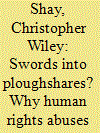

|
|
|
|
|
| Summary/Abstract |
Human rights abuse tends to increase during national crises, such as civil wars and mass nonviolent uprisings. Under what conditions does this abuse abate or persist? I argue that violent challenges provoke much more coercive state responses, exposing more personnel within the security forces to extreme forms of repression and priming them (both leaders and followers) to reproduce these behaviors after the conflict has terminated. This effect is mitigated or avoided when challengers rely on nonviolent tactics instead of violence, leading to less post-conflict abuse. I test this argument with several quantitative methods, which establish a positive association between nonviolent resistance campaigns and subsequent freedom from political killings. Results also suggest that democratization can partially – but not fully – counteract the repressive legacies of violent conflict. By choosing to specialize in nonviolent tactics, therefore, resistance leaders avoid a repression trap that not even democratization can fully disarm.
|
|
|
|
|
|
|
|
|
|
|
|
|
|
|
|
| 15 |
ID:
120765


|
|
|
|
|
| Publication |
2013.
|
| Summary/Abstract |
The events of the Arab Spring of 2011 have made clear the importance and potential efficacy of nonviolent resistance, as well as the field's inability to explain the onset and outcome of major nonviolent uprisings. Until recently, conflict scholars have largely ignored nonviolent resistance. This issue features new theoretical and empirical explorations of the causes and consequences of nonviolent resistance, stressing the role that unarmed, organized civilians can play in shaping the course of conflicts. Contributors demonstrate the importance of treating nonviolent and violent strategies, as well as conventional politics strategies, as alternative choices for engaging the state, show how gender ideology can influence which opposition groups use nonviolent resistance, and suggest that the causes of civil war and nonviolent resistance often differ. Other pieces highlight the role of public attitudes regarding whether nonviolent resistance and violence are employed, how experience with activism and repression by the state can shape activists' perceptions of justice, and how the perceptions of resistance leaders can influence strategic choices. Moreover, several articles examine the key role that security force defections can play in the success of nonviolent resistance, how micro-level nonviolent tactics can improve security in civil war, and how nonviolent campaigns can influence the stability of autocratic states. These contributions suggest that rigorous empirical study of civilian-based contentious politics (rather than only violent contention by armed non-state actors) must be incorporated into the conflict literature. Improved theory and data on the subject will help researchers and policymakers to shape strategies to support these movements when appropriate, and to manage changes in the international system that result from the success of nonviolent uprisings.
|
|
|
|
|
|
|
|
|
|
|
|
|
|
|
|
| 16 |
ID:
120775
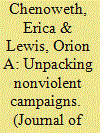

|
|
|
|
|
| Publication |
2013.
|
| Summary/Abstract |
Recent studies indicate that strategic nonviolent campaigns have been more successful over time in achieving their political objectives than violent insurgencies. But additional research has been limited by a lack of time-series data on nonviolent and violent campaigns, as well as a lack of more nuanced and detailed data on the attributes of the campaigns. In this article, we introduce the Nonviolent and Violent Campaigns and Outcomes (NAVCO) 2.0 dataset, which compiles annual data on 250 nonviolent and violent mass movements for regime change, anti-occupation, and secession from 1945 to 2006. NAVCO 2.0 also includes features of each campaign, such as participation size and diversity, the behavior of regime elites, repression and its effects on the campaign, support (or lack thereof) from external actors, and progress toward the campaign outcomes. After describing the data generation process and the dataset itself, we demonstrate why studying nonviolent resistance may yield novel insights for conflict scholars by replicating an influential study of civil war onset. This preliminary study reveals strikingly divergent findings regarding the systematic drivers of nonviolent campaign onset. Nonviolent campaign onset may be driven by separate - and in some cases, opposing - processes relative to violent campaigns. This finding underscores the value-added of the dataset, as well as the importance of evaluating methods of conflict within a unified research design.
|
|
|
|
|
|
|
|
|
|
|
|
|
|
|
|
| 17 |
ID:
189002
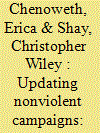

|
|
|
|
|
| Summary/Abstract |
In this article, we introduce an updated version of the Nonviolent and Violent Campaigns and Outcomes dataset (NAVCO 2.1), which compiles annual data on 389 nonviolent and violent mass movements for regime change, anti-occupation, and secession from 1945 to 2013. This version of the dataset corrects known coding errors in NAVCO 2.0, adds news cases (including the Arab uprisings), and codes attributes for each campaign year (such as participation size and diversity, the behavior of regime elites, repression and its effects, support from external actors, and campaign outcomes). In addition, NAVCO 2.1 adds several new attributes to each campaign-year, including more precise participation figures, more nuanced data about the scope, intensity, and degree of violent flank behavior and state repression, and further information about the parallel or alternative institutions developed by the campaign. The data reveal four key findings: (1) that the success rate of nonviolent resistance campaigns has declined since 2001; (2) that far more people have participated in nonviolent than violent campaigns in the postwar period; (3) that nonviolent campaigns suffer far fewer per-capita fatalities than armed campaigns; and (4) that incidental violence by dissidents has become a more common feature of contemporary nonviolent campaigns compared with earlier cases. The article concludes with suggestions for further research.
|
|
|
|
|
|
|
|
|
|
|
|
|
|
|
|
| 18 |
ID:
190021
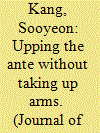

|
|
|
|
|
| Summary/Abstract |
One of the unresolved puzzles in the civil resistance and contentious politics literatures is why some movements that begin seeking limited redress in a certain policy space escalate their claims to demand the ousting of a national leader or the entire regime, a process the article terms ‘demand escalation’. For instance, in the summer of 2019, thousands took to the streets of Hong Kong to protest about a proposed extradition bill that would allow criminal suspects to be sent to mainland China to face trial in courts controlled by the Communist Party. However, even after Hong Kong’s leader, Carrie Lam, announced the formal withdrawal of the controversial bill, protests continued with some calling for greater democracy and others demanding Lam’s resignation. Whereas most of the literature on civil resistance treats demands as fixed and focuses on different methods of struggle to pursue predefined ends, this article shows that demands can change as a result of the state–dissent interaction. The article argues that movements are more likely to escalate their demands when the state responds to the initial nonviolent action with a disproportionate use of force, because such an action intensifies the grievances the protesters have against the state and betrays the remaining trust that people might have had in the government. The analysis of a new quantitative dataset that catalogues both reformist and maximalist opposition campaigns globally supports this claim. By incorporating non-maximalist campaigns into the analysis and not treating demands as fixed, this article adds to our understanding of mass campaigns and highlights an overlooked means by which nonviolent campaigns can up their ante without resorting to violence.
|
|
|
|
|
|
|
|
|
|
|
|
|
|
|
|
| 19 |
ID:
083093
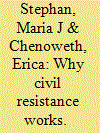

|
|
|
|
|
| Publication |
2008.
|
| Summary/Abstract |
The historical record indicates that nonviolent campaigns have been more successful than armed campaigns in achieving ultimate goals in political struggles, even when used against similar opponents and in the face of repression. Nonviolent campaigns are more likely to win legitimacy, attract widespread domestic and international support, neutralize the opponent's security forces, and compel loyalty shifts among erstwhile opponent supporters than are armed campaigns, which enjoin the active support of a relatively small number of people, offer the opponent a justification for violent counterattacks, and are less likely to prompt loyalty shifts and defections. An original, aggregate data set of all known major nonviolent and violent resistance campaigns from 1900 to 2006 is used to test these claims. These dynamics are further explored in case studies of resistance campaigns in Southeast Asia that have featured periods of both violent and nonviolent resistance.
|
|
|
|
|
|
|
|
|
|
|
|
|
|
|
|
|
|
|
|
|